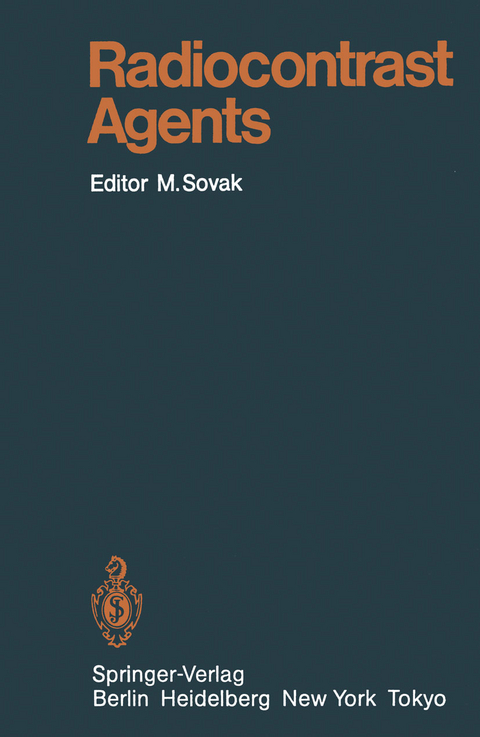
Radiocontrast Agents
Springer Berlin (Verlag)
978-3-642-69517-9 (ISBN)
Contrast media are drugs by default. Had there been no default, there would be no need for a related pharmacology, and thus no need for this book. Radiographic contrast media (CM) are substances whose primary purpose is to enhance diagnostic information of medical imaging systems. The position of CM in pharmacology is unique. First, there is the unusual requirement of biological inertness. An ideal CM should be completely biologically inert, i.e., stable, not pharmacologically active, and efficiently and innocuously excretable. Because they fail to meet these requirements, CM must be considered drugs. The second unusual aspect of CM is that they are used in large quantities, their annual production being measured in tens of tons. It is not in spite of, but because of, the increased use of new radiographic systems, computed tomography, digital radiography, etc., that consumption is on the rise. And, it is not likely that the other emerging imaging modalities - NMR, ultrasonography, etc. - will displace radiographic CM soon; it is quite probable that these remarkable compounds will continue to play an active role in diagnostic imaging in the foreseeable future.
Introduction: State of the Art and Design Principles of Contrast Media.- References.- 1 Chemistry of X-Ray Contrast Media.- A. Introduction and Scope.- B. Biological Requirements.- C. Ionic Contrast Media.- D. Nonionic Contrast Media.- E. Oral Cholecystographic Agents.- References.- 2 Urographic Contrast Media and Methods of Investigative Uroradiology.- A. Introduction.- B. Historical Remarks.- C. Attenuation of X-Rays.- D. Pharmacodynamics.- E. Methods of Investigative Uroradiology.- References.- 3 Contrast Media in the Cardiovascular System.- A. Introduction.- B. Classification of Cardiovascular Actions of Contrast Media.- C. Importance of Experimental Conditions.- D. Specific Effects.- E. Summary.- References.- 4 Basic Methods of Investigative Cardiovascular Radiology.- A. Introduction.- B. Contrast Media.- C. Experimental Cardioradiographic Visualization.- D. Choice of Experimental Animals.- E. The Laboratory for Cardiovascular Contrast Media Research.- F. Cardiovascular Catheterization.- G. Animal Models of Cardiovascular Pathological States.- References.- 5 Contrast Media for Imaging of the Central Nervous System.- A. Introduction.- B. Angiographic Contrast Media in Neuroradiology.- C. Intrathecal Contrast Media.- References.- 6 Basic Methods of Investigative Neuroradiology.- A. Introduction.- B. Anesthesia.- C. Neurovascular Experimental Methods.- D. Experimental Methods for the Subarachnoid Space.- E. Toxicity Screening of Experimental Compounds.- References.- 7 Hepatic Disposition and Elimination of Biliary Contrast Media.- A. Introduction.- B. Anatomic Considerations.- C. Biliary Physiology.- D. Pharmacokinetic Principles.- E. Cholecystographic and Cholangiographic Contrast Media.- F. Concentration of Contrast Media.- G. Gallbladder Function.- H. EnterohepaticCirculation.- J. Renal Excretion.- K. Toxicity.- L. Future for Biliary Contrast Media.- References.- 8 Laboratory Techniques for Studying Biliary Contrast Media.- A. Introduction.- B. Choice of Animal Species.- C. Anesthesia.- D. Holding and Restraint.- E. Administration of Anesthetic.- F. Cannulation of Veins.- G. In Vivo Animal Preparation.- H. In Vitro Liver Preparations.- J. Instrumental Methods of Analysis.- K. Methods of Analysis.- References.- 9 Contrast Media in Lymphography.- A. Introduction.- B. Methods of Lymphography.- C. Physiology and Pharmacology of Lymphokinetics.- D. Animal Models in Investigative Lymphangiology.- E. Experimental Contrast Media for Lymphography.- References.- 10 Contrast Media in Computed Tomography.- A. Introduction.- B. Basic Aspects of Computed Tomography Relevant to Contrast Enhancement.- C. Measurement of Contrast Enhancement with Computed Tomography.- D. Image Manipulation.- E. Dynamic Scanning.- F. Pharmacokinetics of Contrast Enhancement.- G. Practical Applications of Contrast Enhancement.- V. Choice of Intravascular Contrast Medium.- References.- 11 Adverse Systemic Reactions to Contrast Media.- A. General Considerations.- B. Pathogenesis.- C. Pretesting.- References.- 12 Are Contrast Media Mutagenic?.- A. Introduction.- B. Methods.- C. Results.- D. Discussion.- References.- 13 Particulate Suspensions as Contrast Media.- A. Introduction.- B. Particulate Contrast Media.- C. Emulsions.- D. Computed Tomography Enhancement.- E. Other Potential Applications.- References.- 14 Appendix: Basics of Anesthesia for Experimental Animals.- A. Introduction.- B. Anesthesia for Cardiovascular Experiments.- C. Intravenous Anesthesia.- D. Volatile Anesthetics.- E. Short-term Reversible Hypotension.- F. Blood Transfusion.- G. Euthanasia.- References.
| Erscheint lt. Verlag | 19.1.2012 |
|---|---|
| Reihe/Serie | Handbook of Experimental Pharmacology |
| Co-Autor | T. Almen |
| Zusatzinfo | XVI, 612 p. |
| Verlagsort | Berlin |
| Sprache | englisch |
| Maße | 170 x 244 mm |
| Gewicht | 1072 g |
| Themenwelt | Medizin / Pharmazie ► Medizinische Fachgebiete ► Pharmakologie / Pharmakotherapie |
| Medizinische Fachgebiete ► Radiologie / Bildgebende Verfahren ► Radiologie | |
| Medizin / Pharmazie ► Pharmazie ► PTA / PKA | |
| Schlagworte | Agents • Computed tomography (CT) • diagnostic imaging • Medical Imaging • pharmacology • Tomography • ultrasonography |
| ISBN-10 | 3-642-69517-5 / 3642695175 |
| ISBN-13 | 978-3-642-69517-9 / 9783642695179 |
| Zustand | Neuware |
| Haben Sie eine Frage zum Produkt? |
aus dem Bereich


